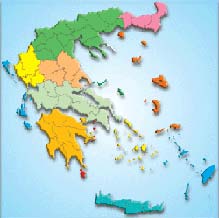
Please click on the map,
the region you want to visit |
|
|
|
|
| |
|
 |
Archaeological Museum |
|
At the Archaeological Museum of Naxos, artworks and everyday objects are exhibited, which came to light by the excavations that were conducted on the island since the Second World War, and are dating from the later Neolithic to the Old-Christian years (5300 BC - 5th century A.D.)
Naxos is the largest and the most important island of Cyclades island complex, a rich place with the appropriate environmental factors for the agriculture and livestock growth. It is also an island with easy mooring, a fact which helped especially to its strong and continuing cultural presence in the Greek land from the late fourth millennium BC until now.
The first heyday of Naxos was during the First-Cycladic II era (2700-2300 BC) during which Naxos and the surrounding small islands were developing into a major commercial and cultural centers of that era. During the subsequent periods of the Bronze Age, several changes and upheavals in the Aegean area had been occurred resulting in the emerging of new centers in other islands (Santorini, Milos, Paros) and Naxos was losing its dominant position in Aegean Sea.
The excavations, the last 40 years, have brought to light numerous archaeological sites (Grotta, Aplomata, Plithos, Melanes, Sagri, Iria, Tsikalario in central Naxos, Panormos, Korfi of Aroni in eastern Naxos) as well as numerous finds which are housed in Naxos Museum.
 Among the archaeological collections of the Museum of Naxos there are important findings, especially of the First-Cycladic period (3200 - 2300 BC) and also from the earlier phases of the historical years, and many of them are unique. Among the archaeological collections of the Museum of Naxos there are important findings, especially of the First-Cycladic period (3200 - 2300 BC) and also from the earlier phases of the historical years, and many of them are unique.
Also, unique is the collection, after the one of the National Archaeological Museum, of the First-Cycladic marble figurines, and the rich Mycenaean pottery collections (late of the second millennium BC) and the Geometric period collections (9th-8th century BC).
The Archaic (7th-6th century BC.), the Classic (5th-4th century BC.) and the Hellenistic (3rd-1st century BC.) periods are represented by distinctive pottery and clay figurines. From the Roman period (1st BC - 2nd century AD), besides pottery, there are also another large and very interesting collection of glass vases.
The archaic sculpture is represented by a few major sculptures. |
 |
THE BUILDING
 The building of the Archaeological Museum has been preached as a historical monument, built in the period from 1600 to 1800 and is an impressive example of the architecture, which was developed in Naxos in its heyday during the Frankish period. The building of the Archaeological Museum has been preached as a historical monument, built in the period from 1600 to 1800 and is an impressive example of the architecture, which was developed in Naxos in its heyday during the Frankish period.
 It is a five-storey building, which was built in the path of the Frankish walls, and includes two of its towers. It was intended for housing a Jesuit school, founded in the 17th century, and ended up at the late of the 19th century - early of 20th century to be the building of the famous commercial school, and among its students was N. Kazantzakis. It is a five-storey building, which was built in the path of the Frankish walls, and includes two of its towers. It was intended for housing a Jesuit school, founded in the 17th century, and ended up at the late of the 19th century - early of 20th century to be the building of the famous commercial school, and among its students was N. Kazantzakis.
Admire the roof of the museum, the unique mosaic floor that was found in a house of the 3rd century BC and which is depicting a half-naked female figure riding a sea monster.
The building was given to the Archaeological Association and was used to house the museum since 1973.
|
 |
 |
 |
I.
II.
III.
IV.
V-VI.
VII-IX.
X.
I.
II.
III.
IV.
V-VI.
VII-IX.
X. |
ARCHAIC SCULPTURE (6th century BC.)
TOMB COLUMNS of the Hellenistic period
SCULPTURES (6th century BC. - Roman period)
First-Cycladic - Mycenaean Period (3200-1100 BC)
GEOMETRIC PERIOD
SCULPTURES, POTTERY AND Small artifacts (ARCHAIC PERIOD - ROMAN YEARS)
TOMB COLUMNS, FRESCOES of a ROMAN HOUSE (3rd century AD.)
|

Open daily except Monday, 08.30-15.00
Tel: (+30) 22850.22.725, (+30) 22850.24.150 |
| Source: 11th. Prehistoric and Classical Antiquities Association |
 |
Accommodation and Entertainment proposals in Naxos |
|
|
|